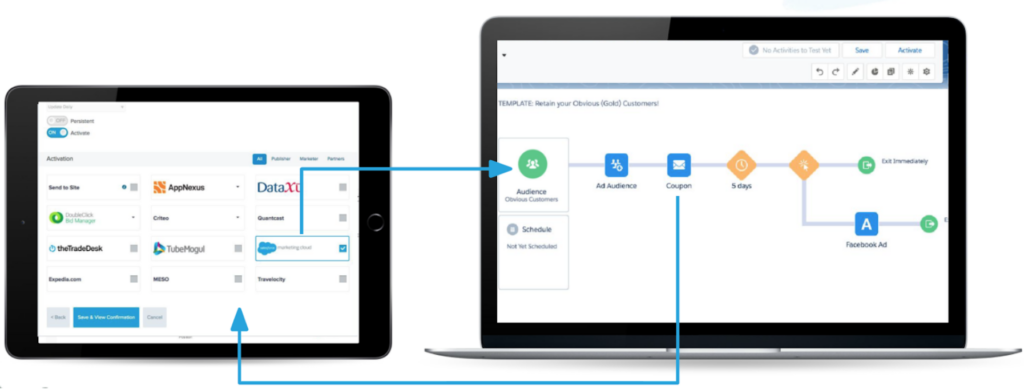Expand your Marketing Cloud capabilities with Audience Studio

In multiple occasions, what we see inside organizations is that the business intelligence is located in silos and we must consider the integration of disciplines and technologies as the first step to obtain value.
The market offers a wide range of types of companies with a profound knowledge in their areas that is necessary to consolidate in order to have a unique vision of the client/prospect.
There are different types of data and utilities that we can get from them, but what is relevant here is that we ensure this integrative vision of the data for its subsequent activation.

Before we continue, I would like to detail some of the basic terms that we will use in this article, to make sure everyone is in the same page.
- Ad-tech: Advertising Technology is a concept related to the use of technology in the field of advertising.
- Mar-tech: Marketing Technology, are the tools used for Marketing teams to manage users, opportunities, purchases… and for the measuring of results and channel attribution.
- Activation or data activation: I mean all that activity that allows us to take advantage of the data we have. Either to carry out advertising campaigns, advertising audiences, qualified audiences or customize content on our website based on these, just to give some examples.
- Native integrations: Those processes and tools that have a direct connection with the DMP. They are usually server-to-server and appear visually inside the interface of the DMP.
- Data in: processes and tools that incorporate data in the DMP.
- Data out: processes and tools that allow you to extract data from the DMP or “activate” them natively.
- Online and offline assets: Any platform of the company in which we work and from which we can retrieve useful data about our users, clients or the business itself. For example, the online ones are usually websites or apps.
- On-site / digital characteristics: I mean on-site when we work with our web and everything we can do it, like customizing users / customers browsing inside.
- Off-site: Off-site activities would be the advertising activation outside our website, with which we try to attract new users or users that we already know and we want them to return. The one in which we can personalize creativity, based on what we know about this target.
- Anonymized data: Data of users who visit us, buy … but who after certain processes (usually encryption) do not allow users to be identified as individuals.

What is Audience Studio and what difference can it make at the strategic level?
Salesforce Audience Studio is a market leading DMP which allows us, in strategic terms, to achieve the following matters:
- Obtain an anonymized benefit from our company’s data, with a varied activation capacity.
- Streamlines and unifies processes to generate communication actions with consumers.
- Unifying the vision and activation of the data of our consumers between departments, helps to break the silos of a company.
- We can coordinate audiences for different purposes, such as on-off site customization, for example, regardless of the origin of the data in.
- Integrating, managing and activating the data of the onsite-offsite assets in the same platform allows us to develop a detailed image of the consumers. What allows them to be more relevant to them through the development of use cases, which is not possible using other technologies.
DMP vs. CDP
One of the pillars we have been years trying to solve is the unification of information that we have of our users: unknown, known and clients, in order to be able to activate their data in an efficient way.
This is why years ago the DMP was born to enable us to orchestrate the communication with our consumers, with the focus placed on ad-tech. In a DMP we gather signals from different proprietary sources, but the main strength is that we incorporate those signals from all the users that we are activating outside our own digital assets. In other words, we are already able to collect data from users who at some point had been impacted by our advertising even though they had not interacted with it.
This allows us to develop a number of very important cases, with the objective of optimizing our advertising actions and achieving the greatest engagement with our potential consumers from the first impact of our brand.
Today, the DMP environment is always changing and we go from:
- Identification of these users by cookies to identifiers that allow us a cross-platform activation. Surely you have heard that cookies will disappear, because the DMP allows users to be recognized through cookies as always, but also through other identifiers such as encrypted (anonymized) email to trace their navigations.
- Pure use cases activated through advertising off-site to the development of omni-channel cases.
- Frameworks that ceased to generate trust to a very detailed management of consents, and control over users that we may or may not activate for various purposes.
On the other hand we find the CDPs where we go from a management of the data of our exclusively anonymized consumers, to a customer / registered user / prospect information base.
One of the objectives of these tools is to unify signals but with a detailed profiling objective of our clients.
In the past we saw them as unknown users, but now we add a vision in which we will know who they are and what they have done with their complete names.
The DMP here stays as a pseudonymous identification, necessary to trace navigations mainly outside our website / app, but without reaching a greater depth of knowledge about these users.
The DMP knows which type of users we impact or customize but from a standpoint of aggregated view, of audience. We do not go further than the CDP can do, where the granular vision by customer profile helps us a lot to develop concrete strategies.
And to understand it visually, this Salesforce chart helps us understand the whole picture:

Where the “Unknown Data” would be all the type of data that we play with in the DMP, and the “Known Data” is the basis of a CDP like the one that Salesforce also has.
On the other hand, we tend towards an even more integrative vision and that is what Salesforce is working with C360 Audiences, where we unite the potential of both worlds / platforms in one. We will talk about this in another moment…
SFAS integration possibilities with SF Marketing Cloud
Salesforce Audience Studio enables the possibility of connecting natively with Salesforce Marketing Cloud through two different ways.
On one hand, in the DMP we can collect information from the impacted users through email and the interactions like clicks that may have happened. Based on that we can create, for example, audiences of users who have received a specific email campaign, and then impact them with advertising outside our website and email campaigns.
On the other hand, we can use DMP audiences regardless of the origin of the data to activate it via Journey Builder within Salesforce Marketing Cloud.
In order to activate data from the DMP and have it available as an input source for a journey, we will only need:
- Collect identifiers that are on both platforms such as encrypted email (SHA256)
- Have the connector contracted / enabled
- Activate an audience for SF Marketing Cloud.

With this, we will be able to develop differential strategies for clients / users. For example, launch an email to users who have seen an advertising campaign for a prominent product of our company. Also knowing that they meet relevant interests to qualify them as high value users.

Why should a profile that manages Marketing Cloud know how to work with SFAS?
As we saw at the beginning of this article, the unification of signals and homogenization of communication is crucial to achieve the global objectives of our company, as well as having a real customer / client centric vision.
Thanks to the knowledge of this type of complementary tools like Salesforce Audience Studio, we can develop differential strategies and unify efforts between departments.
On this matter I would like to use the example of a large retail client we have, with whom, thanks to Audience Studio, we managed to unify the way of working with specific campaigns between the media teams (off-site advertising) and the client (CRM + Marketing Automation), being able to personalize the experience of known users throughout their customer journey. From offsite advertising activation to emailing strategies or SMS.
If you consider that it is vital to know the capabilities of Salesforce Audience Studio, do not hesitate to inform yourself so you can attend the specialized courses.
Did you find this article interesting? Share it!
Maybe your friends will also enjoy this.




